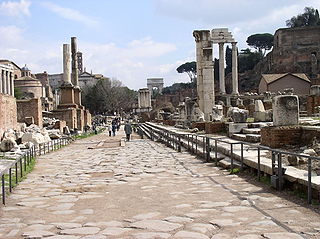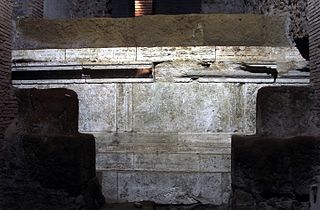
The Roman Forum, also known by its Latin name Forum Romanum, is a rectangular forum (plaza) surrounded by the ruins of several important ancient government buildings at the center of the city of Rome. Citizens of the ancient city referred to this space, originally a marketplace, as the Forum Magnum, or simply the Forum.

The Capitolium or Capitoline Hill, between the Forum and the Campus Martius, is one of the Seven Hills of Rome.

The Temple of Portunus is an ancient Roman temple located in Rome, Italy. It was built beside the Forum Boarium, the Roman cattle market associated with Hercules, which was adjacent to Rome's oldest river port and the oldest stone bridge across the Tiber River, the Pons Aemilius. It was probably dedicated to the gateway god Portunus although the precise dedication remains unclear as there were several other temples in the area besides his. It was misidentified as the Temple of Fortuna Virilis from the Renaissance and remains better known by this name. The temple is one of the best preserved of all Roman temples.

The Forum Boarium was the cattle market or forum venalium of ancient Rome. It was located on a level piece of land near the Tiber between the Capitoline, the Palatine and Aventine hills. As the site of the original docks of Rome and adjacent to the Pons Aemilius, the earliest stone bridge across the Tiber, the Forum Boarium experienced intense commercial activity.

The Temple of Jupiter Optimus Maximus, also known as the Temple of Jupiter Capitolinus was the most important temple in Ancient Rome, located on the Capitoline Hill. It was surrounded by the Area Capitolina, a precinct where numerous shrines, altars, statues and victory trophies were displayed.

The Via Sacra was the main street of ancient Rome, leading from the top of the Capitoline Hill, through some of the most important religious sites of the Forum, to the Colosseum.

The Suburra, or Subura was a vast and populous neighborhood of Ancient Rome, located below the Murus Terreus on the Carinae and stretching on the slopes of the Quirinal and Viminal hills up to the offshoots of the Esquiline.

The Temple of Saturn was an ancient Roman temple to the god Saturn, in what is now Rome, Italy. Its ruins stand at the foot of the Capitoline Hill at the western end of the Roman Forum. The original dedication of the temple is traditionally dated to 497 BC, but ancient writers disagreed greatly about the history of this site.

The Temple of Veiovis in ancient Rome was the temple of the god Veiovis, built sometime in the early 1st century BC.

The Shrine of Vulcan, or Vulcanal, or Volcanal, was an 8th-century BC sacred precinct on the future site of the Roman Forum in Rome, modern Italy. Dedicated to Vulcan, the Roman god of fire, it was traditionally considered to commemorate the spot where the legendary figures Romulus and Tatius concluded the peace treaty between the tribes known as the Latins — on the Palatine Hill — and the Sabines — on the Quirinal and Esquiline. This famous merger of the hill-villages was said to be the foundation of the Roman state.

The Portico Dii Consentes, also known as the Area of the Dii Consentes or the Harmonious Gods, is an ancient structure located at the bottom of the ancient Roman road that leads up to the Capitol in Rome, Italy. The Clivus Capitolinus turned sharply at the head of the Roman Forum where this portico of marble and composite material was discovered and re-erected in 1835.

In ancient Rome, the pompa circensis was the procession that preceded the official games (ludi) held in the circus as part of religious festivals and other occasions.

The Porta Fontinalis was a gate in the Servian Wall in ancient Rome. It was located on the northern slope of the Capitoline Hill, probably the northeast shoulder over the Clivus Argentarius. The Via Salaria exited through it, as did the Via Flaminia originally, providing a direct link with Picene and Gallic territory. After the Aurelian Walls were constructed toward the end of the 3rd century AD, the section of the Via Flaminia that ran between the Porta Fontinalis and the new Porta Flaminia was called the Via Lata ("Broadway").
The lautumiae were tufa quarries that became a topographical marker in ancient Rome. They were located on the northeast slope of the Capitoline Hill, forming one side of the Graecostasis, where foreign embassies gathered prior to appearing before the Roman Senate.

The Temple of Jupiter Tonans was a small temple in Rome, dedicated by Augustus Caesar in 22 BCE to Jupiter, the chief god of ancient Rome. It was probably situated at the entrance to the Area Capitolina, the sanctuary of Jupiter on the Capitoline Hill, near the much older and larger Temple of Jupiter Optimus Maximus. The temple was considered among Augustus's most impressive archaeological projects, and played an important role in the Secular Games, a religious and artistic festival that he revived in 17 BCE. It was also noted by Roman authors for the artworks, particularly statues, displayed in and around it.
The Temple of Mars in Clivo was a temple on the western side of the Via Appia in Rome, between the first and second milestones, built in the early 4th century BCE, and dedicated to Mars. It was the oldest standing temple dedicated to Mars within the city.

The Regio VIII Forum Romanum Magnum is the eighth regio of imperial Rome, under Augustus's administrative reform. Regio VIII took its name from the Roman Forum, the political centre of Ancient Rome.

The Domus Tiberiana was an Imperial Roman palace in ancient Rome, located on the northwest corner of the Palatine Hill. It probably takes its name from a house built by the Emperor Tiberius, who is known to have lived on the Palatine, though no sources mention his having built a residence. It was enlarged by the successors to Tiberius, and would have been the principal Roman residence of Tiberius, Caligula, Claudius, and Nero during the early part of his reign. Relatively little is known of the structure archaeologically, since the Farnese Gardens have occupied the site of the main level since the 16th century, making excavation difficult.
The Arch of Scipio was an ancient Roman arch located atop the Capitoline Hill.

















